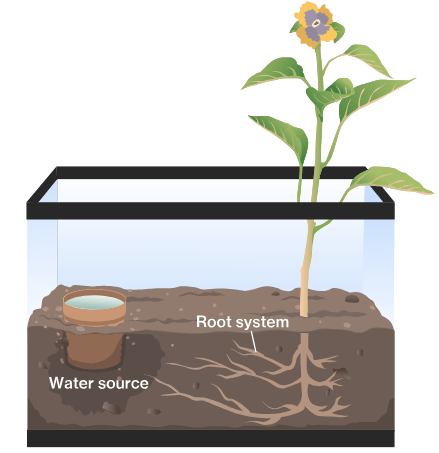Irritability is the ability of an organism to perceive and respond to changes in internal and external environment or stimuli. Stimulus is a change in condition which produces a change in the activities of the organism or part of its body. A stimulus can either be external or internal. External stimuli are those environmental factors that evoke response. Organisms respond to stimulus in three ways namely tactic, nastic and trophic response.
Tactic Response or taxis is a directional type of response or movement in which the whole organism moves from one place to another in response to external stimulus such as light, temperature, water or certain chemical. The response is thus said to directional and positive if the organism moves towards the stimulus or it is negative if it moves away from the stimulus.
– Photo taxis is the response to variation in light intensity
– Chemo taxis is the response to variation in concentration of chemical substance
– Aero taxis is the response to variation in concentration of oxygen
– Osmotaxis is the response to variation in osmotic condition
– Rheotaxis is the response to variation in the direction of the flow of liquid e.g.
Nastic Response or Nastism: This is a type of response in which a part of a plant moves in response to non-directional stimulus such as changes in light intensity, temperature and humidity.
Nastic movements are varied in nature and may be as a result of growth curvature or of sudden changes in tugor.
Nastic responses are usually described according to the stimulus evoking them.
(i) Nyctinasty is a response to changing in day and night condition (temperature) or light e.g.
– The opening of the petals of sun flower in the light and closes in the dark
– The closing of the morning glory flower when light intensity is low
(ii)Haptonasty is the response due to contact or touch
– The infolding of the leaflet of mimosa plant when touched.
– The closing of leaflet of flamboyant tree.
– The nastic movement of floral parts during pollination mechanism and movement of leaves of insectivorous plant
(iii) Hydronasty is the response to humidity changes
(iv) Chemonasty is the response to the presence of chemical
Tropic response or tropism:
This is a type of response in which a part of a plant moves in response to directional stimulus.
Tropism are growth movement named according to the stimulus e.g. phototropism, hydrotropism, chemotropism, haptotropism or thigmotropism, geotropism.
Phototropism is the growth movement in response to light, thus the direction of growth movement depends on the direction of light. The shoot of plant is positively phototropic.
Experiment
Aim: To show that shoots are positively phototrophic
Material Required: Two boxes, seedling growing in pot, knife, aluminum foil
Procedure: The two boxes are arranged in a proper way. Some fermenting bean seeds are placed in two boxes with a hole cut at one end. Box A contains normal seedlings while B contains seedlings with a caps of aluminum. The inside of each box is painted black to prevent light reflection. The entire experiment is put on the window and observed for few days
Observation: The shoot of the seedling in box A will be observed to bend towards the source of light while those in box B do not
Conclusion: Since the shoot of seedlings bend toward light, it shows that the shoot is positively phototrophic
Geotropism: This is a response to gravitational force. The shoot of plant is negatively geotropic while the root is positively geotropic.
Experiment
Aim: To show that plants root respond positively to gravity
Material Required: Bean seedlings, pins and klinostat
Procedure: Select six similar seedlings with straight radicles and plumules. Pin three seedlings to the turnable of a klinostat so that they are horizontal. In the real experiment, do not let turable rotate so that it can receive the stimulus of gravity from one direction. Pin the remaining three seedlings to another klinostat in an identical ways, but allow the turnable to rotate slowly so that the seedlings receive the stimulus of gravity equally on all sides (to serve as control experiment)

Observation: in the stationary seedlings, the plumes will bend and grow vertically upward while the radicles will bend and grow vertically downward. But the seedlings in the rotating klinostat will continue to grow horizontally
Result: The plumule have responded to one-sided gravity by growing away from it i.e. they are negatively geotropic. The radicles (root) however responded by growing towards the direction of the stimulus i.e. they are positively geotropic.
Conclusion: This shows that the roots of plant are positively geotropic.
Hydrotropism: This is the response to water source. Roots of plants will always grow towards a water source

Chemotropism is the response of plant to concentration of chemical substance e.g. roots respond positively to the presence of salt, particularly salt of calcium but negatively to alkaline or acid concentration.
Haptrotropism /(Thigmotropism) is a response of plant to contact and is characteristic of tendrils and other organs by which the plant secures support. Tendrils show positive response to touch by twinkling around a support while roots on the other hand show a negative response to touch by growing away from stones.
Traumotropism: is a response to wounding. Some roots show curvature as a result of damage on one side, the curvature always being away from the injured side.
Thermotropism: is a response to heat
Rheotropism is a response to water current
Read our disclaimer.
AD: Take Free online baptism course: Preachi.com 